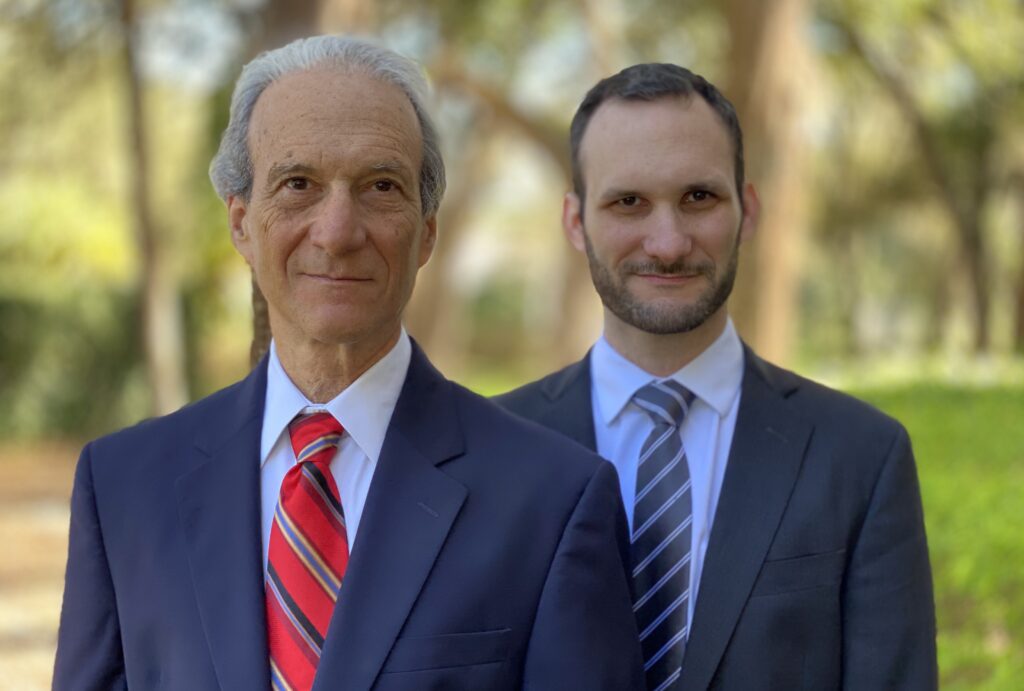Florida Spousal Limited Access Trust (SLAT)
A spousal limited access trust, or SLAT, is an estate planning device that provides asset protection for married couples. This type of trust has advantages over the more common asset protection tool of tenancy by entireties ownership.
Florida law exempts assets owned by married couples as tenants by entireties from execution of judgments against either spouse individually. Entireties protection is lost when the spouses are no longer married because of the death or divorce of the non-debtor spouse. The former tenants by entireties assets could then be exposed to a civil judgment against a surviving debtor spouse. Using SLATs in Florida is an advanced asset protection technique to mitigate this entireties risk.
How to Form a Spousal Limited Access Trust
A SLAT is used for asset protection when a spouse anticipating legal liability creates an irrevocable trust for the benefit of the non-debtor spouse and their children.
Assume, for example, a husband is concerned about legal liability leading to a money judgment. The husband creates an irrevocable trust for the benefit of his wife for as long as she is alive. The husband’s irrevocable trust agreement typically states that income and principal may be distributed or applied for the beneficiary spouse’s health, education, maintenance, and support during the spouse’s lifetime. Children may be additional beneficiaries. The husband or the beneficiary spouse may serve as a trustee of the wife’s trust with the discretion to distribute income and principal to the wife or children. Or there can be an independent co-trustee for enhanced protection. This trust is referred to as a spousal limited access trust due to the wife beneficiary’s lifetime access to trust assets.
SLAT design is flexible regarding the disposition of trust assets after the death of the beneficiary spouse. The trust could provide that trust assets are then distributed or held in trust for children. Or, the trust can provide that upon the death of the beneficiary spouse, the trust assets remain in trust for the benefit of the trustmaker husband in this hypothetical, to be discussed below.
Upon the death of both spouses, the assets typically are distributed or held for the benefit of the couple’s children or other designated heirs. The SLATs may not initially give the trustmaker spouse any rights to income or principal during the lifetime of the beneficiary spouse, and the trustmaker should not serve as the sole trustee of a SLAT. The trustmaker husband may reserve the right to remove and replace trustees.
The SLAT includes asset protection features of typical irrevocable trusts, and accordingly, SLAT assets cannot be reached by the beneficiary wife’s creditors. The SLAT typically includes a standard “spendthrift clause” that prevents the beneficiary spouse from assigning or pledging their trust benefits to a third-party, including a creditor.
We help families throughout Florida.
Our attorneys can help with your entire estate plan. We can provide all services remotely. Start with a free phone or Zoom consultation.

A SLAT Can Be an Asset Protection Trust
Some people consider a so-called domestic asset protection trust (DAPT) to protect an individual’s assets from creditors. A DAPT is a trust designed to protect the assets of a prospective debtor who creates the trust for his own benefit. A trust for the benefit of the trustmaker is referred to as a “self-settled trust.” Some states have laws that protect the trustmaker’s beneficial interest in a self-settled trust. Florida law, however, does not protect assets of self-settled trusts, even if the trust includes asset protection provisions such as spendthrift clauses.
A SLAT can be drafted to act as a self-settled trust where the protection of the trustmaker’s assets does not depend on a favorable state statute. The trust can be designed to include a trust protector (an independent third-party), who has the power to add trust beneficiaries. In the above hypothetical example, where the husband created a SLAT naming his wife as the initial lifetime beneficiary, the trust agreement could provide an independent trust protector the power to subsequently add the husband as an additional beneficiary even during the beneficiary spouse’s lifetime. The trust’s standard asset protection provisions could permit distributions to the husband protected from the husband’s creditors. This customized SLAT could function like a domestic asset protection trust, and protections would be based upon common law trust principles of Florida law.
Even without a customized SLAT with trust protectors, a SLAT offers the trustmaker asset protection after the death of their non-debtor spouse. A standard SLAT provides that after the non-debtor spouse’s death, the trustmaker becomes the primary trust beneficiary and the trustee. Florida statutes protect a beneficiary’s interest in any “spendthrift trust,” even if the beneficiary is serving as trustee of their own trust and controls distributions. If the SLAT is drafted to be a discretionary spendthrift trust for the initial spouse and other beneficiaries, a surviving trustmaker will have a similarly protected right to income and principal.
Change of Florida Law
In the past, there had been an issue regarding the protection of a surviving trustmaker’s interest in a SLAT they created following the death of the trustmaker’s spouse. In the above example, where the grantor husband acquired a beneficial interest in the trust after the death of his non-debtor beneficiary spouse, a creditor could argue that the SLAT is an unprotected self-settled trust when the husband becomes a beneficiary of a trust he had created.
The Florida legislature resolved this issue through a change to the Florida trust code in 2022. The new statute provides that the grantor of a SLAT is not considered to be the settlor of an irrevocable trust if (1) the trust benefits the trustmaker only after the death of the trustmaker’s spouse, (2) the trust does not benefit the trustmaker during the spouse’s lifetime, and (3) the initial trust funding was a completed gift for tax purposes. The new SLAT law allows a debtor to retain a future protected interest in the property they convey to a SLAT for their non-debtor spouse.
According to the Florida statute, the deceased spouse is considered the settlor of the SLAT that the trustmaker initially created, and the trustmaker’s asset protection will not be lost by the same SLAT being considered a self-settled trust.
Advantages of a SLAT vs. Tenants by Entireties
A SLAT protects a debtor spouse’s separate assets and the entireties assets during the marriage and also in the event the non-debtor spouse predeceases the debtor spouse. In the example, after the debtor husband conveys his assets irrevocably to a SLAT for his wife’s benefit, the SLAT assets are not exposed to a judgment against the grantor husband because he no longer owns the assets. If the wife dies, unlike with entireties ownership, there is no loss of protection. This is because the husband’s trust names himself as the successor trustee, and the trust is designed to make discretionary payments of income and principal to the grantor husband upon his wife’s death. SLAT distributions are protected from the husband’s creditors by the SLAT’s spendthrift clause and the discretionary nature of distributions.
Divorce Issues with SLATs
A properly drafted SLAT should deal with the possibility of divorce. No spouse wants to create an irrevocable trust that could continue to benefit their spouse following a divorce. The solution is a “variable spouse” provision that defines the trustmaker’s spouse as the person they are married to at any time. A trust agreement might state that upon divorce, or filing for a divorce, the beneficiary spouse’s interest in a SLAT would terminate, and the trustmaker’s descendants would become the current beneficiaries unless and until the debtor finds a new spouse.
Estate Planning Benefits
A SLAT may provide estate tax savings in addition to asset protection. Transfers to SLATs may be completed gifts for tax purposes, or they could be incomplete gifts. The nature of the gift is determined by powers retained by the trustmaker in the SLAT agreement.
With an incomplete gift, the SLAT assets remain the trustmaker’s property for purposes of gift and inheritance taxation. With a completed gift, the current value and future appreciation of property are permanently removed from the trustmaker’s taxable estate.
Completed gifts to a SLAT may be subject to gift tax in the year of transfer. Transfers within the annual gift exclusion (currently about $17,000 per person/recipient in 2023) are excluded if the trust agreement gives the beneficiary a present interest in the gift through “withdrawal rights.” Transfers in excess of the gift exclusion apply to the trustmaker’s lifetime inheritance credit which is currently about $13 million as of 2023
Key Points
The most important things to know about a SLAT are as follows:
- A SLAT plan involves one spouse creating and funding an irrevocable trust for the other spouse under terms that provide income during the beneficiary spouse’s lifetime and a reversion to the trustmaker spouse after the beneficiary spouse’s death.
- The SLAT cannot be amended or revoked; it is irrevocable.
- SLAT assets are protected from the beneficiary spouse’s creditors during his or her lifetime.
- SLAT assets remain in trust after the beneficiary spouse’s death, where they are protected from the trustmaker spouse’s creditors.
- Florida law says that a SLAT is not considered a “self-settled trust” by the trustmaker spouse after the beneficiary spouse’s death, even though the trustmaker spouse created the trust from which they may ultimately benefit.
- A SLAT may be drafted to reduce estate tax liability because appreciation in trust assets is not counted toward the value of the couple’s taxable estates after their deaths.
- Transfers of assets to a SLAT should be made as completed gifts for asset protection purposes.
Sign up for the latest information.
Get regular updates from our blog, where we discuss asset protection techniques and answer common questions.








